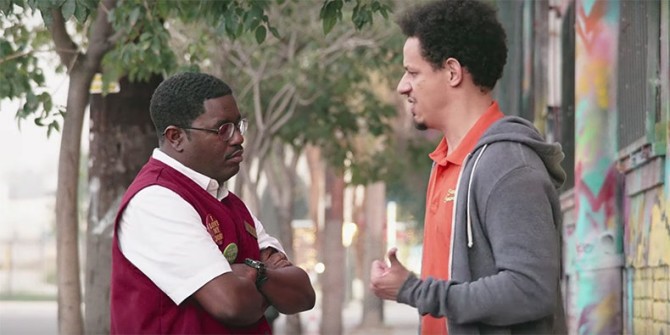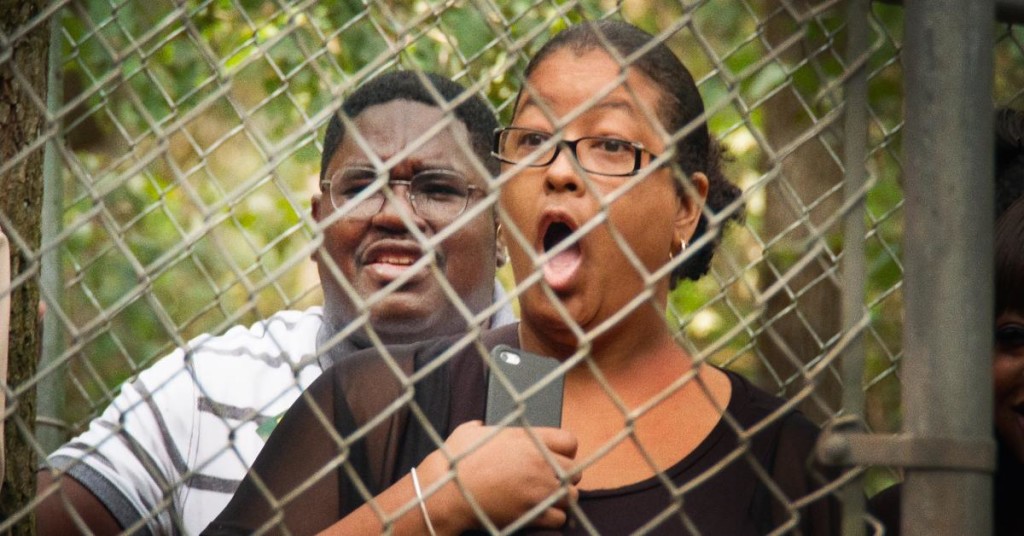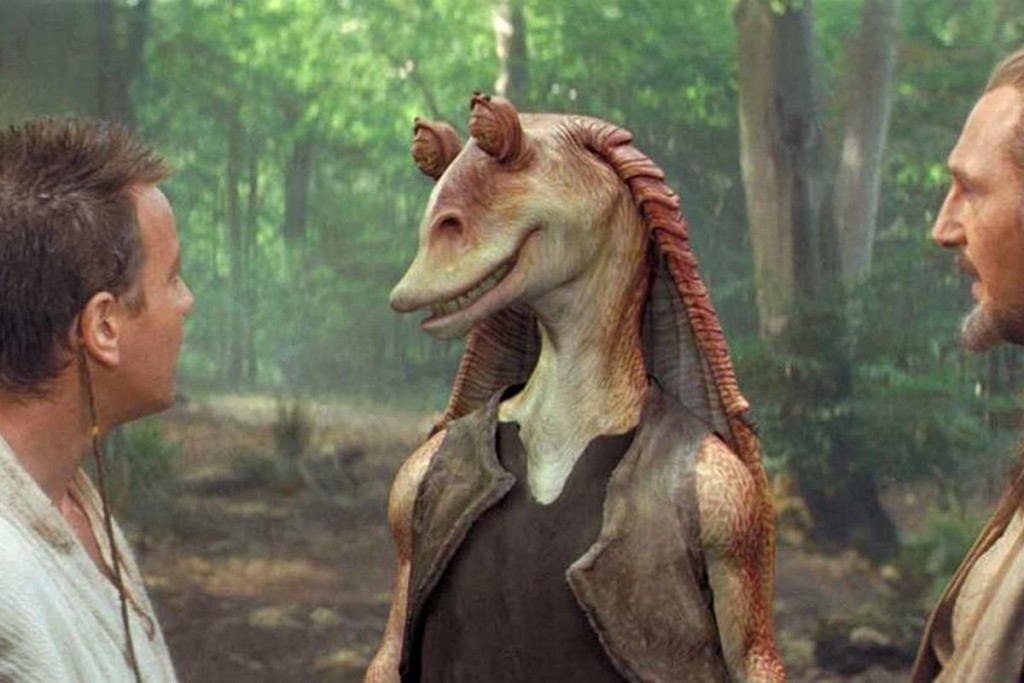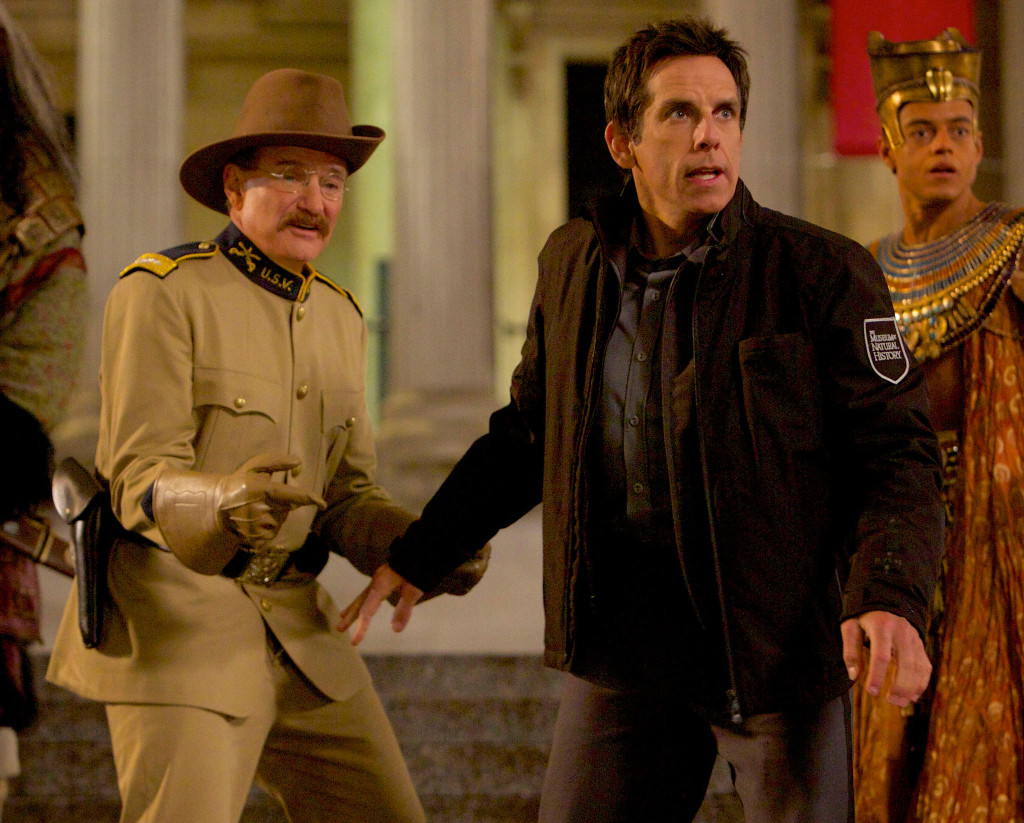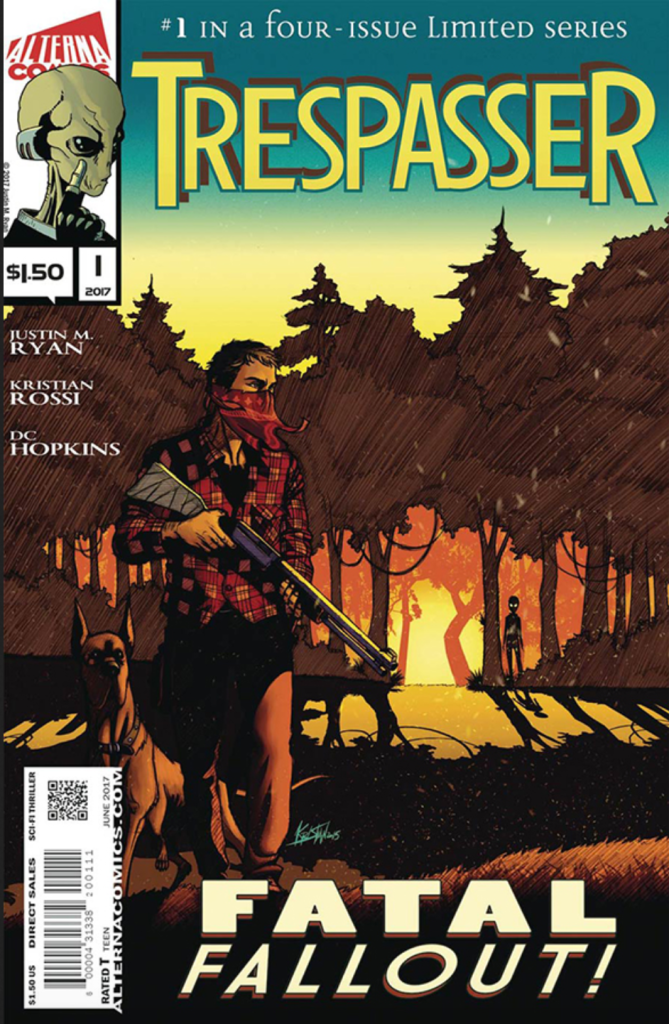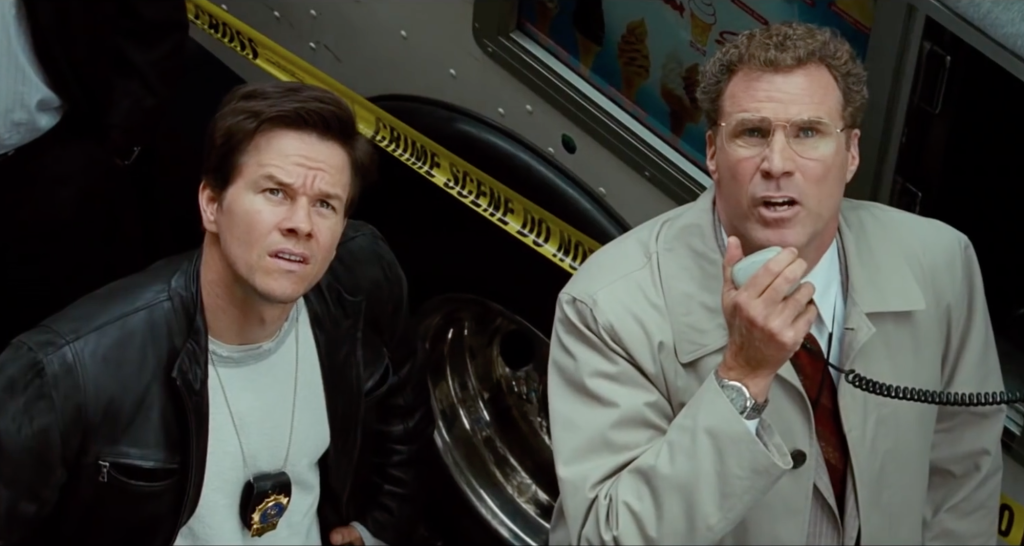When I was looking for examples from funny comedies for my Thursday article, I nearly broke out in hives. As I searched high and low, I couldn’t find any movies that I felt were genuinely funny all the way through. I started to wonder if I’d outgrown comedy features altogether. Comedies are made for the 12-25 crowd. I’m not that.
Then I watched Bad Trip.
And I could not stop laughing.
It wasn’t just how funny the movie was. It was how *inventive* it was. I’ve never seen a movie quite like it.
Bad Trip is basically a re-make of Dumb and Dumber. A Florida car wash employee, Chris, runs into his high school crush, Maria, while on the job. After getting the courage to talk to her, he learns she’s only in town for the day and is heading back to New York, where she works as an art curator.
The impulsive Chris tells his best friend, the wimpy and introverted, Bud, that he wants to go to New York, tell Maria he loves her, and hopefully live happily ever after. Bud is reluctant at first but agrees to join him. They go on a road trip to New York and hilarity ensues!
Sounds pretty basic, right?
Well, here’s the catch.
The spine of the movie is a fictional narrative but all of the set pieces are prank scenes. The best way to explain it is you know the scene in Dumb and Dumber where Lloyd and Harry stop at the diner and piss off Sea Bass? Imagine if, in that scene, Jim Carey and Jeff Daniels walked into a real diner with real people who had no idea they were in a movie, and pissed off a real Sea Bass?
That’s Bad Trip. It’s a real movie narrative mixed with a bunch of scenes where the people surrounding our heroes have no idea they’re in a movie. I’ve never seen that before.
Now some of you may say, “Uh, Carson. Have you not seen Borat?” It’s hard to explain but Bad Trip is nothing like Borat. Borat’s schtick is finding real people and making them admit they’re racist or sexist or something. It usually revolves around one person, with him occasionally doing a performance scene, like a concert or a wrestling match.
In Bad Trip, almost all of the prank scenes involve multiple onlookers. For example, the two friends get in an elaborate car crash and a dozen clueless [real people] come to their rescue, none the wiser. And they’re all seamlessly (for the most part) woven into the narrative. It’s a thing of beauty.
The genius of the comedy is that Eric Andre, who plays Chris, is willing to take the comedy as far as it can go. Then we get to watch a bunch of real people react to it. For example, early on in the movie, while at the mall, Chris decides he’s going to travel north to see Maria and is so excited he starts a random dance number right there in the food court. As other actors join into the choreographed dance, the looks on the real mall-goers’ faces are priceless. They genuinely have no effing idea what’s going on.
So why haven’t you heard of this movie?
I’ll tell you exactly why.
Because it’s not politicized.
It follows two black men who head up north and not a single gag they’re involved in is race-related. In fact, there’s a scene where they stop at a big redneck bar where they’re the only two black people there, and the bulk of the scene shows how well everyone gets along with each other. You can’t have white people and black people happily getting along in a 2021 movie.
That’s what really won me over about Eric Andre’s comedy. All he cares about is making you laugh. And he doesn’t do it at the expense of anyone. Imagine a Borat movie where Sascha Baron Cohen wasn’t allowed to make anyone look bad. There wouldn’t be a Borat. Yet, in Bad Trip, every single scene is about Eric and Lil Rel Howery being the butt of the joke. There’s not a single scene where a random person is the butt of the joke. Not only do I respect that. But that’s much harder to do.
The question I was asking myself was, what can comedy writers learn from this movie? I struggled with that because it’s such a unique film. But I did have a couple of takeaways.
First, there’s value in trying something different. What made this movie so fascinating was how different it felt from every other comedy film. You’re trained to think that everything has been done already. But this is a reminder that it hasn’t. You have to think that with new things popping up on the internet every day, there is still opportunity for you to come up with the next unique comedy concept. I mean, has anyone made a Zoom comedy yet? Seems like a slam dunk with the right concept. And hey, you still have a month and a half before the Comedy Showdown deadline. So maybe start writing that Zoom comedy now!
The second thing I learned was more traditional. And that is, when it comes to comedy, you want to take the reader right up to the edge…. You want to make them think that you’re finished… and then you want to go past it.
One of the biggest laughs in the movie occurs when Chris and Bud go to the zoo. While a tour of real people are watching the exhibits, Chris notes to Bud that the gorilla exhibit door has been left open. Since the silverback gorilla is currently asleep, Chris sneaks in to get a daring selfie with it.
The people then watch in horror as the [unknowingly fake] gorilla awakens and attacks Chris in… well, let’s just say it attacks him in sexual way. It’s both hilarious and way too much at the same time. Chris is able to escape the gorilla and barely get back through the gate door. The zoo-goers are besides themselves, happy that Chris narrowly escaped death but also mortified at what they just saw. Legitimately, there are a couple of people who are traumatized.
As zoo employees are called and everyone’s asking Chris if he’s okay, Chris realizes that he dropped his cell phone in the exhibit. So he GOES BACK IN TO GET IT. Everyone’s trying to stop him but Chris has to get his phone. And, of course, when the gorilla sees him again, he attacks Chris a second time in an even more mortifying way.
Take them right up to the edge, make them think you’re done, then go past it.
Speaking of edges, it looks like the Oscars have finally plummeted over the edge and into the abyss. There has never been an Oscars with this many movies that nobody has seen. I am not exaggerating when I say that some of these movies haven’t been seen by more than 1000 people. Yet they represent our industry’s best! Wooo!!! Here are my quick thoughts on every major movie on the list…
Sound of Metal – I tried SO HARD to watch this movie over the weekend just so I could say I watched one Oscar movie. No scenes. Just a bunch of scene fragments. Typical indie randomness. Starts off being about a deaf drummer then it becomes about addiction. So it’s a movie about deafness or a movie about addiction? So confused. Gave up after 40 minutes.
Mank – Quite possibly the most rambling incoherent film in the Oscar race. And that’s saying something.
Minari – Whenever I see a poster with a group of depressed people in a field, I know there’s a 180% chance I’m not going to like the movie. Didn’t see this. Don’t plan to. Nobody can convince me it’s good.
The Trial of The Chicago Seven – I mean, Sorkin wrote it so it probably has some good moments. But this subject matter doesn’t interest me. Not going to watch it.
Ma Rainey’s Black Bottom – I’m as interested in 1920s blues singers as I am a group of depressed people in a field. Not sure if I would’ve seen this if it was the only movie released all year.
Nomadland – I’m convinced this movie was created to make the world a more depressing place. I mean come on. How do movies like this get made? Seriously.
Promising Young Woman – Read the script a couple of years ago. Gave it an “impressive.” Director looks like they made the script even better. As far as I’m concerned, this is the only movie on the 2021 Oscar list that looks like it deserves to be there.
By the way, where’s I Care A Lot??? That movie was a thousand times better than any movie on this list. If you’re pushing me for writing winners, I’m guessing Nomadland wins for Adapted Screenplay only because no one’s giving a goofy comedy (Borat) an Oscar. And Nomadland has gotten a bigger marketing campaign than any other movie on the list, which means more voters will have actually heard of it. Not the best way to win best writing but you take what you can get. Promising Young Woman will win for Original Screenplay. I know Sorkin’s in that category but unless he can figure out a way to be female between now and 5pm, he’s probably not going to win. Oh, and finally, the one and only movie I actually want to win an Oscar tonight: MY OCTOPUS TEACHER!!! Go octopuses!
Today, I want to bring you back to one of the defining characters in cinema history. He was introduced to the world on May 19, 1999.
His name?
Jar-Jar Binks.
Jar-Jar Binks was the brainchild of George Lucas. And while you wouldn’t know it today, he was supposed to be the most important character in the prequel trilogy. He would start out as the comedic relief in Phantom Menace before becoming a wise master in Revenge of the Sith.
That never happened because the world revolted against him. But I’m not concerned about Jar-Jar’s fate in today’s post. I’m focused on how Lucas made a critical comedy mistake when constructing this character. A mistake that ensured he would not be the comedic relief he was meant to be. Want to know what this mistake was?
GEORGE LUCAS ACTIVELY TRIED TO MAKE JAR-JAR FUNNY.
Now we’re going to get into a trippy thought-provoking topic today so stay with me because it’s admittedly confusing but here’s the premise of the post: The act of trying to make something funny is what makes it unfunny.
You’ve probably met that person at the party who’s desperately trying to make everybody laugh. And, yet, the more he tries, the less funny he becomes. Why is that?
Well, when somebody is actively seeking validation from you through laughter, it creates a “try-hard” vibe that dilutes the humor. It becomes more about them getting you to laugh than you actually laughing.
That’s the vibe Jar-Jar Binks gives out whenever he’s in a scene. He is not interested in talking to Ani. He’s not interested in figuring out how to outwit Watto. He’s not concerned about how they’re going to get off this desert planet. Jar-Jar Binks is only there to stand in front of all of the other characters, look directly into the camera, and make you, the audience laugh.
He is the ultimate embodiment of a try-hard comedic character.
For comparison’s sake, let’s take a look at an earlier comedic character of Lucas’s, Yoda. Yoda is hilarious. He gets in a fight with R2-D2, whacking his cane against him. He makes a bunch of jokes that only he thinks are funny and he doesn’t care if you agree or not. He has this weird way of talking backwards. He orders this giant human around. He steals food.
Yoda doesn’t care if the audience laughs or not. He is existing inside the reality of the movie, which is why what he does is so funny.
This leads me to the three cornerstones of writing a good comedy script. They are the concept, the characters, and the scenes. However, it is how you approach these three cornerstones that decides whether your movie will be funny or not.
You are not trying to come up with a funny movie idea. You are trying to come up with a movie idea that will provide the opportunity for comedy. You are not trying to come up with funny characters. You are trying to come up with characters whose personas lead to organically funny actions. You should never try to write a “funny scene.” You should construct scenes that best open up the opportunities for funny moments.
Let’s go through these one at a time.
When coming up with a concept, you’re looking for a giant situation that creates the most opportunity for comedy. Wedding Crashers. That’s a concept that, in the title alone, you can start to see the opportunity for a bunch of funny scenes. And they come to you organically. You don’t have to force anything to find them.
Same thing with Night at the Museum. You get stuck in a museum overnight where everything inside the idea comes to life. So many funny scenes are going to come from that premise without you even having to try.
Conversely, look at the Adam Sandler comedy, Hubie Halloween. That movie is about a weirdo who stumbles around his town on Halloween night. It is the definition of “try-hard.” There’s no clear concept where you can imagine funny scenarios. It is solely about a character TRYING TO BE FUNNY on an unusual night of the year. Even before the movie has started, we get the sense that characters will be desperately attempting to make us laugh, just like the unfunny guy at the party.
This extends into character-creation as well.
You don’t want to be in the headspace of, “I need to make this character really funny.” That thought-process is what creates the problem. You’re going to bypass the movie and directly focus on making the audience laugh. Which is when they never laugh. It’s the Jar-Jar Binks effect.
Instead, create characters who provide the potential for being funny within the situations they’re in. Annie (Kristin Wiig) in Bridesmaids is this really jealous person. That’s the core of her character. It’s not, “Wacky Girl.” It’s “Jealous Girl.” Then, all the movie has to do is put Annie in a bunch of situations that expose her jealously.
Like a pretty teenager coming to buy a necklace at the jewelry store Annie works at. She’s excited about hanging out with her best friend later. Annie, meanwhile, has lost her best friend to this other chick who’s fast replacing her. So Annie starts making nasty quips to the teenager about how friendships never last, which devolves into insult-hurling, until Annie finally calls the customer the c-word.
It’s a really funny scene. But I never got the sense that the character was trying to make me laugh. All of her humor came via the insecurity she harbored due to her jealousy.
Finally, you want to extend this to your scene-writing. You should never try to write a “funny scene.” You should, instead, come up with a scene that provides you with the most potential for funny moments.
If you’re writing a golf comedy, for example, you want to look for unique scenarios that mine the best opportunities for laughs. So you put the angriest golfer in the world in a mini-golf course. Or you put him in a celebrity pair-up tournament. Without me even having to explain these scenes, you’re already thinking up funny moments.
All of this seems obvious after-the-fact. But I’m the one who has to read all the amateur comedies where the writers don’t think of this stuff. They don’t think of forcing Happy Gilmore to learn how to putt on a mini-golf course. They focus on the golf tournaments and love story only and their comedy ends up being bland.
When you do all this right, it comes together in a beautiful way and leads to lots of funny scenarios. For example, the movie, “Spy.” That movie is about an introverted CIA desk agent who must become a field agent for the first time. That idea creates a bunch of funny scenarios. The main character is going to be funny just through the sheer act of trying to learn the practice of spying on the job. And there are going to be plenty of scenarios that offer potentially funny outcomes. Just having to sit down with an international kingpin during lunch and convince her that you’re a regular person — that offers plenty of opportunities for jokes.
Finally, I’m the first to admit that the rules of comedy are complicated. We often laugh at things we’re not supposed to laugh at. Or didn’t think we’d laugh at. There are times, such as in “Ace Ventura, Pet Detective,” where the main character is clearly interested in making the audience laugh, and it still works. So I’m not saying that this is only way to write comedy.
What I am saying is this formula gives you the best chance of writing a good comedy script. Even if you can only get two out of the three in there, you still have a good chance of writing a good comedy. In the meantime, if you catch yourself writing lines, characters, or scenes in a desperate attempt to make people laugh, I can guarantee you that’s when your comedy isn’t going to work. And if you ever need a reminder of why, pop in every scene of Jar-Jar Binks in The Phantom Menace. He’ll remind you. :)
Genre: Sci-Fi/Horror
Premise: A father and daughter living in remote isolation must fight for survival after aliens arrive seeking revenge for killing one of their own.
About: This one is based on a graphic novel. Jason Fuchs, who co-wrote Wonder Woman, joined up with Endeavor Content to secure the rights. The pitch here was “Another Quiet Place.” Goes to show that mentioning recent breakout movies as a comp goes a long way towards selling something. This script finished with 8 votes on last year’s Black List. Writer Gabe Hobson has not yet secured any writing credits, although he’s working on an HBO project with Alec Berg, who produces the great, “Barry,” for HBO. When is Barry coming back????
Writer: Gabe Hobson
Details: 107 pages
It’s a double dip of sci-fi ice cream this week.
The Gorge was fun. Can Trespasser surpass it???
We’re out in the middle of rural Alaska. I guess that’s a redundant sentence. All of Alaska is rural. But anyway, 40 year old Hector Ramos is teaching his 10 year old daughter, Maria, how to hunt. Quick aside here. I have read somewhere in the neighborhood of 500 “fathers teaching their offspring how to hunt” scenes in screenplays. I strongly advise against them for that reason.
Although I wasn’t thrilled about the hunty-teachy scene, it’s followed up with a pretty cool chase scene. Hector and Maria load the caribou they killed onto a basket trailing their snowmobile and a bunch of hungry wolves begin pursuing them to steal their kill. That was cool.
Once at home, Maria expresses interest in what’s “beyond the river” that she’s never able to cross and Hector is super sketchy with his answer. We get the feeling that he’s keeping a big secret from her. That night, after her dog goes missing, Maria heads out to look for him and finds a little 4 foot humanoid black creature caught in one of their bear traps.
She calls her dad out and he’s freaked out by the thing. Says to leave it there. But Maria is so intrigued, she comes back later and feeds the alien. It seems nice. The next day, when Hector learns his daughter went back out, he’s furious and kills the thing! That very same day, Maria spots another alien. And then another!
She runs back to the house and, by that time, five aliens are in pursuit! Lucky for her, these aliens are not up to date on breaking and entering procedure for Alaskan cabins as they get all confused by the walls and windows and such. That gives Maria enough time to stall for Hector to come back. The two will then have to defeat the creatures who are dead set on getting revenge for the murder of their alien brother!
For those who don’t know, there was a screenplay written forever ago that was Steven Spielberg’s original idea for E.T. It was based on a real story where a redneck family was [supposedly] terrorized by a group of little aliens who were trying to break into their house. I’m guessing this, at least, partly inspired Trespasser?
Hey, I don’t blame ya. You can do worse than Steven Spielberg’s scraps.
I was so underwhelmed by this script, though.
As I read it, I was trying to figure out why it wasn’t working. More specifically, I was trying to figure out why the movie, Alien, works but this doesn’t.
Both of them have nefarious aliens in them. Trespasser actually has more than one. In both cases, the characters are contained to a certain location and are being stalked by the alien. And yet, I wasn’t once invested in or worried about these characters. I bounced a number of ideas around in my head as to why, never coming up with a satisfactory answer.
I would argue that you should be even more invested in Trespasser’s protagonist than Alien because Trespasser’s protagonist is a 10 year old girl. Who isn’t rooting for a 10 year old girl to not get killed by evil aliens? If you’re one of the few, keep it to yourself you heartless bastards.
In the end, I think it comes down to something simple.
The creature itself.
The creature in Alien started off as this mysterious football-sized thing that attached itself to your face. There’s something scarier about an alien whose makeup we don’t yet understand. You’re not even sure what you’re looking at.
Then, of course, the alien grows inside the body, bursts out of the chest, and becomes an even more horrifying creature the larger it grows.
In Trespasser, you basically have five 4-foot tall black humanoids. I’m sure if I was the target of one of these things, I might be less brave than I’m claiming to be now. But something that’s small – in this case as small as a ten year old – I’m just not sure how fearful I can be in a movie setting. Especially because they’re humanoid and familiar. There’s no mystery to them.
This is something I tell writers quite a bit. When you’re creating a villain – whether that villain is a killer or a monster or an alien – you need to describe something to us that feels unfamiliar in some sense. Because the unknown is what’s scary. The more we know about something, the less scary it is. That’s why when I watched Alien for the first time and that face-hugger attached itself to one of the crew-members, I was trying to figure out what the hell was going on. That’s what was so scary about it.
Ditto The Thing. You didn’t know what you were dealing with there on that base. That’s a big reason why it was so terrifying.
It just seems kind of silly to have a bunch of little men chasing your hero around. I’m struggling to find the fear-factor in that. Especially when they don’t even know what to do when they encounter walls. How scary can something be when it sees a house and goes, “Un oh. Now we’re screwed.”
The one good thing this script had going for it was the mystery of why the father had dragged his daughter into the middle of nowhere to live. We kept getting these hints that he wasn’t telling her the whole truth. Maybe even lying completely about the reason they lived in the wild. That mystery was the only reason I wanted to turn the pages.
If there’s something to learn from this script, I’d tie it into my contemplative weekend I referred to in the Monday post. Go and scroll through the thumbnails of four streaming services for fifteen minutes. Look at the sheer number of options people have. Understand what you’re competing with. That way, when you think five little humanoids are a good idea for scary alien monsters, you might check yourself and consider another, more menacing, option.
[ ] What the hell did I just read?
[x] wasn’t for me
[ ] worth the read
[ ] impressive
[ ] genius
What I learned: Is your villain/monster/alien/demon actually MENACING. If they’re not menacing, we’re not going to be afraid of them. I didn’t know whether to run from these humanoid trespassers or pick them up and pet them.
What I learned 2: Add the 1,249,081st script to the “Dead Kid Backstory” pile. Just in case you were thinking it was a good idea to add a dead kid backstory to your next script.
Genre: Mystery/Horror/Sci-Fi
Premise: Deep in the middle of Europe is a mysterious gorge that has been guarded since World War 2. An American Sniper is sent to the gorge by the US military for the latest watch. What he finds there shocks him.
About: The great thing about selling a script is that when you’ve got another one, there’s a good chance that same company will buy that too. That’s what’s happened here. Skydance, which just made Zach Dean’s “The Tomorrow War,” bought this Dean script as well. The Gorge is being sold as a weird love story but hold the train on that description. It’s more of an original sci-fi horror idea. Dean is one of the few writers out there at the moment selling cool spec scripts. If you’re a “I want to sell a spec” guy, you want to pay attention to Dean’s career.
Writer: Zach Dean
Details: 109 pages
Long-time Black List participant, Zach Dean, is one of the more dependable screenwriters in town. I’ve liked every one of his scripts. More recently, he’s gone from Black List darling to A-List Hollywood screenwriter, penning Chris Pratt’s new movie, The Tomorrow War (which recently signed a deal with Amazon). But Dean has yet to write his Magnus opus, his screenplay that truly shows he’s a master of the craft. This one sounded different so I figured, if there’s a script that’s finally going to get him there, it’d be this one. Let’s take a look-see at…… THE GORGE!
Levi is a special operations sniper. You send him out in the middle of nowhere to take out a drug kingpin from a mile away, then fly him back home. But Levi’s next mission will be unlike anything he’s experienced before. It’s so unique, in fact, that nobody tells him what it is. They simply tell him it’ll take a year.
After a long flight, Levi is dropped over an endless forest with a map. He follows the map and comes across an enormous gorge. The gorge is so deep that it is constantly filled with fog. Levi spots a watchtower where an Australian sniper, JD, greets him. JD has been on this beat for the past year. And boy is it a doozy.
JD explains that Levi’s only job for the next year will be to make sure nothing gets out of that gorge. There are these things, nicknamed “hollowmen,” that try to crawl out of there sometimes. Your job is to shoot them. Oh yeah, you’re in charge of the west side of the gorge. And if you look over there, there’s another watchtower where someone is in charge of the east side.
JD leaves with one last tidbit. There’s a rumor that after you complete your service at the gorge, they kill you. Nice. Something to look forward to. After a couple of nights in the watchtower, Levi hears celebrating across the gorge. Levi picks up his sniper scope to look across the way and sees that his co-guard, Drasa, is partying it up. When she realizes Levi is looking at her, she starts writing messages for him to see. It turns out it’s her birthday. She’s celebrating.
Over the course of the next few weeks, they write messages to each other until, finally, Levi shoots a cable over to the other side of the gorge and ziplines across it! The two spend the night of all nights together and, the next day, when Levi ziplines back, the zipline BREAKS! Which means, that’s right, Levi falls into the gorge!
The bottom of the gorge is a bunch of trees, a stream, and a never-ending supply of a weird-smelling fog. Drasa jumps down into the gorge to save Levi and they’re immediately attacked by Hallowmen (basically, zombies). They begin to put the pieces together. This was some strategic base for World War 2 before something went wrong and it needed to be abandoned. And when Levi runs into his old buddy JD, now 20 years aged, he realizes just how wrong things got.
I have to give it to Zach Dean. He knows how to come up with a high concept. More importantly, he knows how to keep surprising the reader.
When you come up with an idea like The Gorge, you have two ways you can go. You can keep everything on the surface – focus on the two watchtower guards and their ongoing attempts to keep the hollowmen from escaping the gorge. Or you can do what Dean did. You can go into the gorge and fully embrace your concept.
Both options have pros and cons. The first option creates a situation based on mystery. We, the audience, are wondering what’s going on in the gorge. And we fill in the blanks with our own imagination. Usually, the reader’s imagination of what’s happening is better than anything the writer can come up with. So it’s fun to play in this sandbox.
However, your story ends up being a lot simpler. I actually thought this is the route Dean was going to take and he would focus more on the love story. So falling into the gorge was quite the surprise.
The second option gives you more of a movie. You get to visit hell instead of just talk about it. The problem is explaining everything. You have to come up with an entire mythology about the Gorge that’s unique and intereting. Most writers aren’t able to do that. The “hollowmen” the average writer comes up with ends up being generic and the more you explore that world, the dumber it gets. That’s what I experience in the majority of similar scripts I read.
Dean gave me a little more than that. But I wished he would’ve pushed further. We ultimately find out that the hollowmen are former watchtower guards who have been thrown down here after their watch, and that this World War 2 experimental site is turning them into creatures.
Dean did a good job setting up the World War 2 connection early in the script so all of this felt like an organic payoff. But, like a lot of mystery scripts, the more you thought about it, the less it made sense. After each watch, the guards are dropped down here, where they become hollowmen, that the new guards must keep from getting out. But wouldn’t it be easier to just kill everyone after their watch? Instead of adding to the Hallowmen population?
I don’t know. Maybe I wasn’t supposed to think that much.
It was a fun script regardless and it did keep me guessing. For those reasons, this is worth a read. But I’m sad that Dean still hasn’t executed his perfect script yet. He’s got the talent. He just needs to push himself more.
Actually, that’s a lesson we could all remind ourselves to follow. Push beyond what you think you’re capable of. That’s where the best writing lies.
[ ] What the hell did I just read?
[ ] wasn’t for me
[x] worth the read
[ ] impressive
[ ] genius
What I learned: One of my favorite moments in this script is when JD, before he passes the torch to Levi, says to him, “There’s one more thing I have to tell you. There’s a rumor that after you finish your watch, they kill you.” The reason I like this is because it subconsciously introduces a reason to keep reading. If I stop reading, I never find out what happens after the watch. I never find out if it’s true that they kill you. Any little trick you can use to convince your reader to keep reading, use it. Nothing is off-limits. If you can get someone to read your entire script, you’ve done more than most amateur writers. Most people bail on scripts long before that. Take a page out of Zach Dean’s book and introduce something in the future that your reader has to find out if it’s true.
Week 0 (concept)
Week 1 (outline)
Week 2 (first act)
Week 3 (first half of second act)
Week 4 (second half second act)
Week 5 (third act)
I had a contemplative moment this weekend.
I was trying to find something to watch after a long day of work. I checked Netflix. I checked HBO Max. I checked Disney Plus. I checked Hulu. I checked Peacock. I checked Amazon Prime. I even sat around for several minutes convinced that I owned another streaming service that I’d forgotten about.
Long story short, I couldn’t find anything to watch.
But that’s not what made me introspective.
The sheer volume of movie/show thumbnails I scrolled through was an eye-opener. There was so much. I still remember the days when you turned on the TV and you had five choices. You went to the movie theater and you had one, maybe two choices.
To see all of this stuff in front of me available with a single click was almost scary. How can any writer possibly surprise an audience anymore? Or write something original?
There are only so many ways you can arc a character. There are only so many plot tricks you can use. There are only so many ways you can tell a story. Is it even possible, anymore, to write something that feels unique? That feels honest and original? Has this ocean of media swallowed that option up?
I thought about that for a long time. I had two good hours since I wasn’t able to find anything to watch, remember.
I came to the conclusion that, yes, it is still possible to achieve these things. The analogy that convinced me was that we have billions of people on this planet. We run into people all of the time. And yet we still end up meeting people we really like. Maybe as a friend. Maybe as a romantic interest. Maybe as mentor or a business connection.
In other words, we never get bored of people, despite how many of them there are.
That tells me that we’ll never get bored of good TV shows and good movies.
However, we must concede that there is more competition for storytelling than ever before. And, for that reason, giving 65%, 75%, 85%, even 95%, of what your story could be isn’t enough. It has to be 100%. You have to give your all. You have to be able to look at your script and say, “This is the best I can do.” If you want ANY shot at breaking into the business, that’s the bar you need to clear. Because there are plenty of above average projects floating around Hollywood. You need to write something beyond that to get noticed.
The question then becomes, what gets you to 100%?
The answer is REWRITING.
Most first drafts will be lucky to cross the 50% threshold. That means, after one draft, your script is 50% of what it could be. Which, obviously, means, you’ve got 50% to go. While it would be nice if that 50% was writing a second draft, that’s not how it works. If you’re doing it right, your second draft might get you to 65%. And, from there, you’re aiming for each draft to get you another 5%. If you can write a great script under 10 drafts, you’ve done an amazing job.
Remember that Good Will Hunting was rumored to have 50+ drafts. Uncut Gems had something like 200 drafts. But I consider that overkill if you’re doing your job right. A good rewriting strategy can get you to that 10 draft marker.
So what is rewriting?
Rewriting is about identifying problems in the current draft and coming up with solutions. And that’s what we’re going to do this week. We’re going to read our script and we’re going to figure out the five (rough estimation, could be more or less) biggest things that are wrong with it. But in order to do that well, you need to put your script down for at least a few days. That means, either Wednesday or Thursday, you’re going to pick your script back up and read the whole thing from start to finish.
What I want you to focus on while reading is how you feel during the read. Don’t focus on characters or plot yet. Just focus on, are you bored? Are you annoyed? Is this section good? Is this section bad? Your emotions will signal to you when something isn’t working. Write all that down. Note every time where something doesn’t feel right. Or even doesn’t feel as good as it could be.
Once you’ve done that, go back through your notes and ask WHY you felt that way. The WHY is where you will find your answers for how to approach the next draft.
I’m working with a writer on a sports script right now and one of the first things we noticed while re-reading the script was how disinterested the main character felt. This was by design, something that the hero would learn and correct over the course of his character transformation. But it didn’t work. The disinterest led to a passive character, and that’s something you can’t have in a sports movie. Your hero needs to be active.
There were also subplots that didn’t work. Whenever our hero was around certain characters, their scenes would drag. It was a telling sign that those characters weren’t working.
There were also parts of the script that felt disconnected from the main storyline. This was a sports movie and yet certain situations had our character a thousand miles away from his sport. There were legit reasons why these choices were made during the writing of the script, but if something doesn’t work, it doesn’t work.
One of the hardest things to get right is your hero’s transformational arc. They start with a flaw. They gradually learn about their flaw. And then, at the end, they overcome the flaw. This is hard to execute in a first draft because flaws are negative and you want your hero to be likable. So you’re trying to find that balance between likable and flawed. And then you’re trying to set up an ending that organically allows your hero to overcome the flaw. It’s asking a lot of one draft. So you almost always need to play with this and fine tune it over multiple drafts.
Sometimes things just don’t work out the way you thought they would. Your amazing villain turned out to be cheesy and forgettable. All of this is common in a first draft and none of it should deter you. This is what rewriting is about.
So I want you to read your script Wednesday or Thursday with fresh eyes. I want you to write down everything that isn’t working. And then just start to consider solutions. Some solutions will come to you quickly. For example, if your hero is unlikable… give him a couple more likable traits! Or add a save the cat moment.
Some solutions you won’t have answers to right away. I once wrote a comedy script with four main characters (think Eurotrip). Three of them were guys. One was a girl. And it just wasn’t working. The energy my female character was bringing wasn’t funny for some reason. So I battled over getting rid of the female character and replacing her with a guy. But then it’s an all guys movie and that didn’t feel right either. So maybe I needed to reinvent her so she was funnier.
You have to make decisions like that all the time in screenwriting. Sometimes you have to marinate on these problems for a while before you come up with a solution. That’s what this week is about. It’s about reading your script, figuring out what isn’t working, writing down the obvious solutions, then taking the rest of the week to try and solve the more complex issues.
The good news is, you don’t have to figure everything out this week. Normally, I prefer you have at least a month before you write your second draft. You want a solid plan going into this draft. But we’re working on an accelerated schedule, so we’re going to do this in two weeks. This week is about identifying the problems. Next week is about coming up with an official outline for our second draft.
For those of you who want to rush this and start your second draft right away, I encourage you to try this method instead. At the beginning of this post, I talked about the unbelievable volume of media you’re competing against. To be better than all those other thumbnails, you need to take this seriously. You need a plan of attack every time you write a draft. That’s what I’m trying to teach you. Have a plan of attack so that you get the most out of each draft. That way, you’ll get 15% closer as opposed 3% closer.
A big shout out to everyone who’s stayed up to date with their writing. Awesome job. I’m super proud of you!

